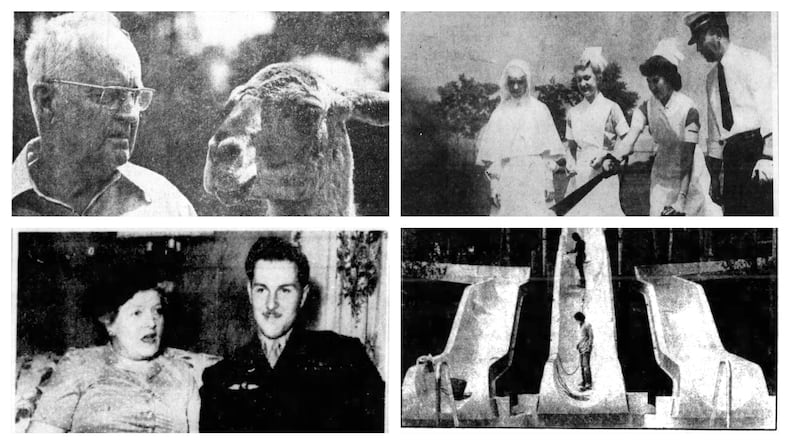Here’s a look at some stories from the week of June 2-8.
June 2, 1945: Daytonian fleeing German prison talked with Nazis
Lt. Jack Sturm, 22, was home visiting his mother on a 60-day leave after serving 32 months overseas.
The P-51 fighter pilot had flown 47 missions during that time and had also escaped a German prison camp.
Sturm had shot down six enemy planes during his missions and was eventually shot down over Munich in April 1944.
Sturm and another soldier he met at the prison camp, Joseph Hummel, of Illinois escaped from Stalag-Luft 3 and spent 15 days on the run before finding American lines.
“Several times we were stopped by Germans,” he said. “I died a thousand deaths in those minutes, but Joseph could speak German quite fluently and I had picked up a few words. We told them merely that we were ‘going home’ which, of course, was the truth.”
The former Fairview high school student earned the Distinguished Flying Cross with one cluster, the Air Medal with five clusters and the Purple Heart.
June 5, 1955: Firefighting nurses all set for blazes
Part of the curriculum for first-year St. Elizabeth School of Nursing students involved learning how to fight fires.
Eighty first-year students had to “graduate” from a 10-hour course on firefighting.
The course was the only one of it’s kind held for nurses in Dayton and one of a few of its kind in the nation.
Classwork included learning causes of fires, types and operation of extinguishers and patient evacuation.
For the final exam, Capt. Thomas Rosenfelt of the Dayton fire division training school touched off oil, gasoline and other types of blazes on the back lawn at St. Elizabeth and let the students take over putting them out by picking out the proper extinguisher type.
Other first year courses for nurses included “making beds” and “giving baths.”
June 4, 1965: Car phonographs going on auction block
Police were auctioning off several automobile record players during the annual police auction. Capt. G.W. O’Connor said he would advise persons not to use the phonographs in their cars.
“If drivers want distraction,” he said, “the radio is sufficient.”
About 190 bicycles were again leading the list of items to be sold during the auction.
Most of the auctioned property was either confiscated by police or stolen merchandise which was recovered but unclaimed.
Proceeds were to go to the police pension fund.
June 8, 1975: Man collects exotic beasts, llama right in backyard
Paul Reece worked in the maintenance department at Wright State University. He lived right next door on 10 acres.
On his property he kept seven llamas, eight deer, a peacock and other animals. He had a rhea, known as a South American ostrich, which liked to run and shriek.
Reece had been collecting exotic animals for 35 or 40 years and loved to have them close by. He obtained most of his animals from zoos.
His field ran along Colonel Glenn Highway, and sometimes cars would stop and ask him about his animals.
“Sometimes people stop and ask about them,” he said, “but hardly ever. It seems like the general public today isn’t interested in anything that has anything to do with nature.”
June 2, 1985: Surf’s up at The Beach waterpark
In 1985, the now-defunct The Beach waterpark in Mason was about to open for the first time.
Opening day was eight days away and the park did not look like it would be ready in time. Crews were busy with bulldozers, cement trucks and construction on the forms for swimming pools, water flumes and sidewalks.
Walt Davis, the general manager of the $9 million, 35-acre park near Kings Island, wasn’t worried. He insisted the “amusement park where you wear your swimsuit” would be ready on time.
The rides had names like the Lazy Miami, Banzai, Typhoon, Thunder Beach (the wave pool) and Tuba Rapids.
Emerald Bay, the adult pool, ranged from three to 11 feet deep. It included a “lily pad walk,” a series of bobbing floats you could try to walk on.
The “beach” of The Beach was made of 2,500 tons of sand, filled the areas between the pools.
At opening, The Beach could accommodate 7,000 visitors, but had the plans to double or triple the capacity over time if there was enough demand.
Admission was $9.50 for adults and $8.50 for children. Parking was $1.
About the Author






